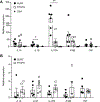Undifferentiated recurrent fevers in pediatrics are clinically distinct from PFAPA syndrome but retain an IL-1 signature
- PMID: 33636366
- PMCID: PMC8089050
- DOI: 10.1016/j.clim.2021.108697
Undifferentiated recurrent fevers in pediatrics are clinically distinct from PFAPA syndrome but retain an IL-1 signature
Abstract
Autoinflammatory disorders of the innate immune system present with recurrent episodes of inflammation often beginning in early childhood. While there are now more than 30 genetically-defined hereditary fever disorders, many patients lack a clear diagnosis. Many pediatric patients are often grouped with patients with periodic fever, aphthous stomatitis, pharyngitis, and adenitis (PFAPA) syndrome despite failing to meet diagnostic criteria. Here, we categorize these patients as syndrome of undifferentiated recurrent fever (SURF), and identify the unique features which distinguish them from the PFAPA syndrome. SURF patients were more likely to report gastrointestinal symptoms of nausea, vomiting and abdominal pain, and experienced inconsistent responses to on-demand steroid therapy compared to PFAPA patients. For this previously undefined cohort, an optimal course of therapy remains uncertain, with medical and surgical therapies largely driven by parental preference. A subset of patients with SURF underwent tonsillectomy with complete resolution. Flow cytometric evaluation demonstrates leukocytic populations distinct from PFAPA patients, with reduced CD3+ T cell numbers. SURF patient tonsils were predominantly characterized by an IL-1 signature compared to PFAPA, even during the afebrile period. Peripheral blood signatures were similar between groups suggesting that PFAPA and SURF patient tonsils have localized, persistent inflammation, without clinical symptoms. These data suggest that SURF is a heterogenous syndrome on the autoinflammatory disease spectrum.
Keywords: Autoinflammation; Pediatrics; Periodic fever; Recurrent fever.
Copyright © 2021 Elsevier Inc. All rights reserved.
Conflict of interest statement
Disclosures of Conflicts of Interest
The authors declare no conflicts of interest.
Figures



References
-
- Papa R et al. Next generation sequencing panel in undifferentiated autoinflammatory diseases identify patients with colchicine-responder recurrent fevers. Rheumatology (Oxford) (2019). - PubMed
-
- Harel L et al. The First International Conference on Periodic Fever, Aphthous Stomatitis, Pharyngitis, Adenitis Syndrome. J Pediatr 193, 265–274 e3 (2018). - PubMed
-
- Broderick L, Kastner DL & Hoffman HM Recurrent Fever Syndromes. in Primary Immunodeficiency Diseases: A Molecular and Genetic Approach (eds. Ochs HD, Smith CIE & Puck JM) (2013).
Publication types
MeSH terms
Substances
Grants and funding
LinkOut - more resources
Full Text Sources
Other Literature Sources
Medical

